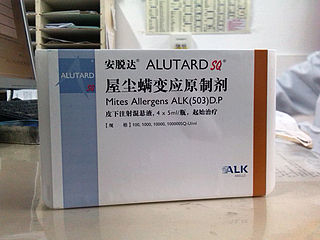
Allergies, also known as allergic diseases, are various conditions caused by hypersensitivity of the immune system to typically harmless substances in the environment. These diseases include hay fever, food allergies, atopic dermatitis, allergic asthma, and anaphylaxis. Symptoms may include red eyes, an itchy rash, sneezing, coughing, a runny nose, shortness of breath, or swelling. Note that food intolerances and food poisoning are separate conditions.
An allergen is a type of antigen that produces an abnormally vigorous immune response in which the immune system fights off a perceived threat that would otherwise be harmless to the body. Such reactions are called allergies.

Aerobiology is a branch of biology that studies the passive transport of organic particles, such as bacteria, fungal spores, very small insects, pollen grains and viruses. Aerobiologists have traditionally been involved in the measurement and reporting of airborne pollen and fungal spores as a service to those with allergies. However, aerobiology is a varied field, relating to environmental science, plant science, meteorology, phenology, and climate change.
Most ants are capable of biting, stinging, and spraying irritant chemicals. However, only relatively few species can harm humans; among which some can cause significant injury or, in rare cases, death. Like wasps, individual ants are capable of stinging multiple times as they do not lose their stingers.

Eosinophils, sometimes called eosinophiles or, less commonly, acidophils, are a variety of white blood cells and one of the immune system components responsible for combating multicellular parasites and certain infections in vertebrates. Along with mast cells and basophils, they also control mechanisms associated with allergy and asthma. They are granulocytes that develop during hematopoiesis in the bone marrow before migrating into blood, after which they are terminally differentiated and do not multiply.
A radioallergosorbent test (RAST) is a blood test using radioimmunoassay test to detect specific IgE antibodies in order to determine the substances a subject is allergic to. This is different from a skin allergy test, which determines allergy by the reaction of a person's skin to different substances.

Rhinitis, also known as coryza, is irritation and inflammation of the mucous membrane inside the nose. Common symptoms are a stuffy nose, runny nose, sneezing, and post-nasal drip.
Vega machines are a type of electroacupuncture device used in pseudoscientific Vega testing, which proponents claim can diagnose allergies and other illnesses. The forerunner to the Vega test was electroacupuncture according to Voll developed by Reinholdt Voll in the 1950s. Helmut Schimmel modified the technique in the 1970s and presented it under the name Vega test.

Allergen immunotherapy, also known as desensitization or hypo-sensitization, is a medical treatment for environmental allergies, such as insect bites, and asthma. Immunotherapy involves exposing people to larger and larger amounts of allergens in an attempt to change the immune system's response.

A hypoallergenic dog breed is a dog breed that is purportedly more compatible with allergic people than are other breeds. However, prominent allergen researchers have determined that there is no basis to the claims that certain breeds are hypoallergenic and, while allergen levels vary among individual dogs, the breed is not a significant factor.

Selective immunoglobulin A (IgA) deficiency (SIgAD) is a kind of immunodeficiency, a type of hypogammaglobulinemia. People with this deficiency lack immunoglobulin A (IgA), a type of antibody that protects against infections of the mucous membranes lining the mouth, airways, and digestive tract. It is defined as an undetectable serum IgA level in the presence of normal serum levels of IgG and IgM, in persons older than 4 years. It is the most common of the primary antibody deficiencies. Most such persons remain healthy throughout their lives and are never diagnosed.

Azelastine, sold under the brand name Optivar among others, is a H1 receptor-blocking medication primarily used as a nasal spray to treat allergic rhinitis (hay fever) and as eye drops for allergic conjunctivitis. Other uses may include asthma and skin rashes for which it is taken by mouth. Onset of effects is within minutes when used in the eyes and within an hour when used in the nose. Effects last for up to 12 hours.

Dysgammaglobulinemia is a type of immune disorder characterized by a reduction in some types of gamma globulins, resulting in heightened susceptibility to some infectious diseases where primary immunity is antibody based.

Bioaerosols are a subcategory of particles released from terrestrial and marine ecosystems into the atmosphere. They consist of both living and non-living components, such as fungi, pollen, bacteria and viruses. Common sources of bioaerosols include soil, water, and sewage.
Transient hypogammaglobulinemia of infancy is a form of hypogammaglobulinemia appearing after birth, leading to a reduction in the level of IgG, and also sometimes IgA and IgM.
Autoimmune progesterone dermatitis(APD) occurs during the luteal phase of a woman's menstrual cycle and is an uncommon cyclic premenstrual reaction to progesterone. It can present itself in several ways, including eczema, erythema multiforme, urticaria, angioedema, and progesterone-induced anaphylaxis. The first case of autoimmune progesterone dermatitis was identified in 1964. Reproductive function may be impacted by APD.

Fixed drug reactions are common and so named because they recur at the same site with each exposure to a particular medication. Medications inducing fixed drug eruptions are usually those taken intermittently.
Oral mite anaphylaxis (OMA), also known as pancake syndrome, is a disease in which a person gets symptoms after eating food contaminated with particular mites. The disease name comes from reports of people becoming ill after eating pancakes made from contaminated wheat or corn (maize) flour.
The toxicology of fire ant venom is relatively well studied. The venom plays a central role in the biology of Red imported fire ants, such as in capturing prey, and in defending itself from competitors, assailants, and diseases. Some 14 million people are stung annually in the United States, suffering reactions that vary from mild discomfort, to pustule formation, swelling, and in rare cases, systemic reactions followed by anaphylactic shock. Fire ant venoms are mainly composed (>95%) of a complex mixture of insoluble alkaloids added to a watery solution of toxic proteins. For the Red imported fire ant Solenopsis invicta Buren there are currently 46 described proteins, of which four are well-characterised as potent allergens.
John Malcolm Hirst was a British aerobiologist, known for his invention of the Hirst spore trap, which enabled accurate, routine estimates of spore and pollen concentrations found in the atmosphere. The spore trap was a breakthrough in understanding epidemics of plant disease, identifying airborne allergens, and predicting pollen danger alerts for people with allergic rhinitis. Soon after the invention, many such spore traps were installed by hospitals.











